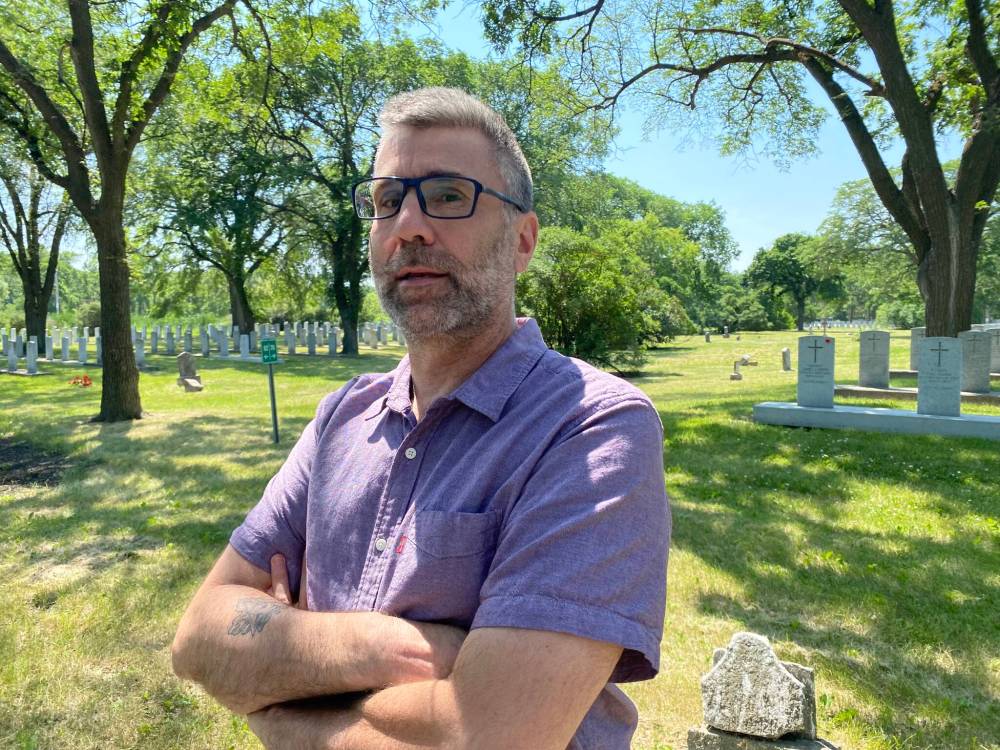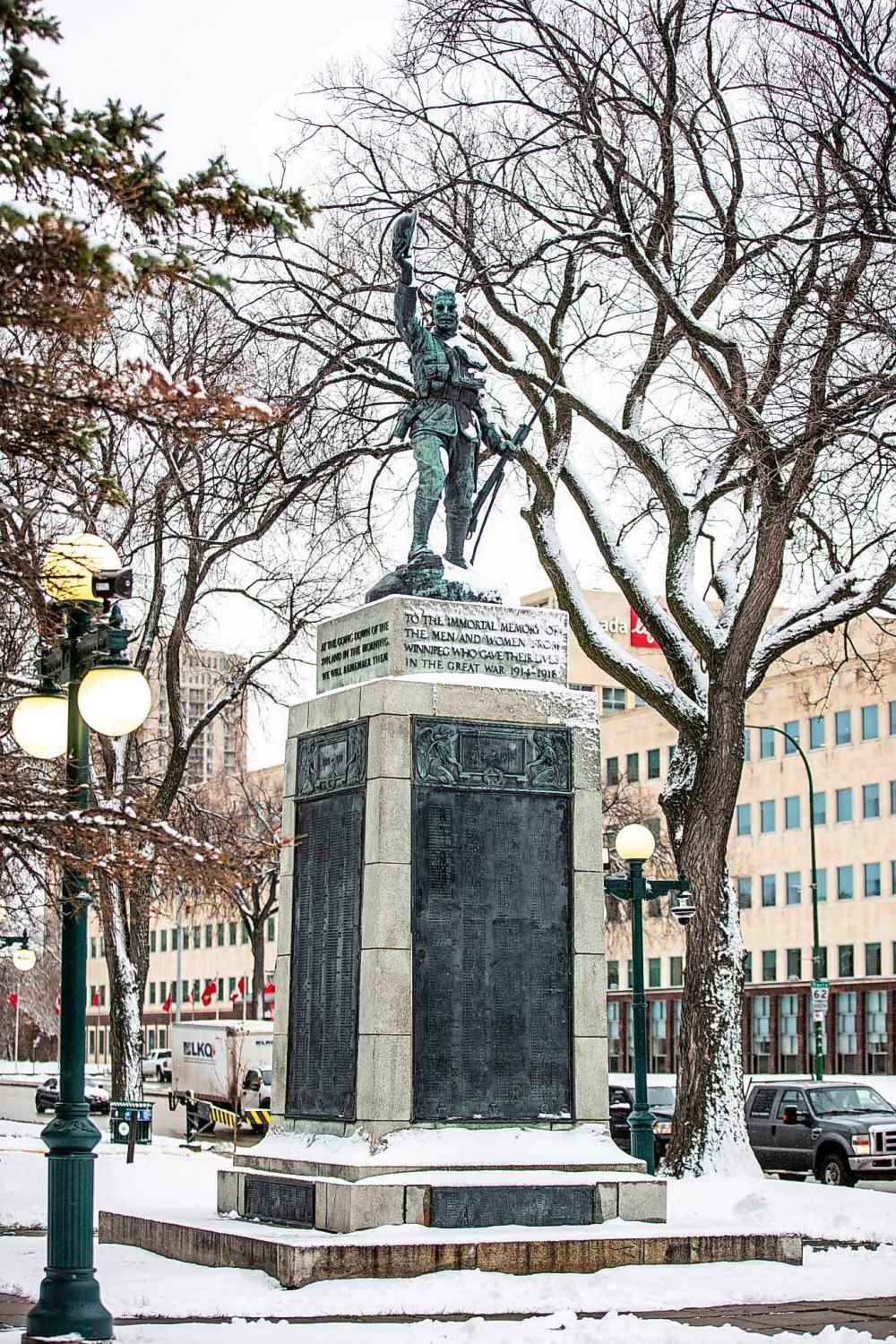Paying homage to heroes
Morden historian seeks to learn about lives of soldiers named on war memorial
Advertisement
Read this article for free:
or
Already have an account? Log in here »
To continue reading, please subscribe:
Monthly Digital Subscription
$0 for the first 4 weeks*
- Enjoy unlimited reading on winnipegfreepress.com
- Read the E-Edition, our digital replica newspaper
- Access News Break, our award-winning app
- Play interactive puzzles
*No charge for 4 weeks then price increases to the regular rate of $19.00 plus GST every four weeks. Offer available to new and qualified returning subscribers only. Cancel any time.
Monthly Digital Subscription
$4.75/week*
- Enjoy unlimited reading on winnipegfreepress.com
- Read the E-Edition, our digital replica newspaper
- Access News Break, our award-winning app
- Play interactive puzzles
*Billed as $19 plus GST every four weeks. Cancel any time.
To continue reading, please subscribe:
Add Free Press access to your Brandon Sun subscription for only an additional
$1 for the first 4 weeks*
*Your next subscription payment will increase by $1.00 and you will be charged $16.99 plus GST for four weeks. After four weeks, your payment will increase to $23.99 plus GST every four weeks.
Read unlimited articles for free today:
or
Already have an account? Log in here »
Hey there, time traveller!
This article was published 10/11/2023 (737 days ago), so information in it may no longer be current.
Richard Van Neste. William Oliver Dalgleish. David Lawson Walker. Edward George Lowman.
Along with about 1,600 others from Winnipeg who were killed during the First World War, they are listed on the Next of Kin memorial at the northwest corner of the Manitoba legislature grounds, at the intersection of Broadway and Memorial.
The names mean a lot to Darryl Toews, who teaches history at Morden Collegiate Institute.

Heather Menzies photo
Darryl Toews, who teaches history at the Morden Collegiate High School, is passionate about the history of war.
“I’m passionate about the history of that war,” said Toews, 53. “What made those men make that ultimate sacrifice and how can we remember them?”
Since 2014, Toews has made it his mission to learn more about the men listed on the monument.
In his research, he learned Van Neste was a schoolmaster and gardener who died Nov. 10, 1917; Dalgleish was a farmer, who died April 10, 1917; Walker was a bank clerk, who died April 24, 1918; Lowman was a stockbroker, who died Feb. 19, 1917.
Toews’s mission started on the 100th anniversary of the beginning of the First World War. “I wanted to know more about the names on the memorial in Morden,” he said of the 43 men listed there.
Toews reached out to Gordon Goldsborough of the Manitoba Historical Society, who provided help. Goldsborough also had a question for Toews: would he volunteer to help research other Manitobans who died in the 1914-18 war?
Toews said yes.
Using digital archives (such as Library and Archives Canada), Toews estimates he’s tracked down information for about 95 per cent of the Next of Kin monument list (http://wfp.to/6hx).
Now, he’s doing research on all of Manitoba’s First World War dead — more than 10,000 in all.
This is no small task; there are an estimated 400 or so name-bearing monuments, memorials and plaques scattered throughout the province in town squares, cemeteries and churches.
“I’m always learning about a monument I didn’t know about,” Toews said, noting he recently learned about a monument dedicated to French-speaking Manitobans who had signed up with the French army and were killed in action.
“We promised to remember them,” he said. “This is the least I can do to keep their memory alive.”
The Next of Kin memorial was erected 100 years ago, by citizens upset by the City of Winnipeg’s slow pace in honouring its war dead.
A project of the Winnipeg Soldiers’ Relatives Permanent Memorial Association, it is topped by the likeness of a victorious soldier who, in the words of its maker, Marguerite Taylor, is celebrating the moment when “peace was declared, when the victorious soldier threw his rifle into his left hand and triumphantly whirled his tin hat in the air.”
She wanted to portray a happy soldier, so “bereaved wives and mothers would not be too much saddened when they looked at it.”
The push to erect the monument was made in 1920 by seven men — all relatives of deceased soldiers — who were indignant no permanent war memorial had yet been erected by the city.

G. W. Cooper, one of the founding members of the Soldiers’ Relatives association, said: “It makes my blood boil to think that the people who lost their loved ones have to assume the responsibility of erecting a monument to their memory. It should not be left to us to do it. It should be done by the citizens of Winnipeg as a whole. It was a stigma on the name of Winnipeg that nothing had been done so far.”
To pay for the memorial, which cost $15,000, donations were solicited from relatives of deceased soldiers; the City of Winnipeg contributed $2,500.
When it was unveiled, an editorial in the Winnipeg Tribune said it called attention “to a condition of affairs in which Winnipeg can take no pride. Namely, the fact that there is still no civic memorial to the soldiers who made the great sacrifice… Let us hope that before another year passes a suitable civic memorial will have been erected.”
Winnipeg’s official memorial to its First World War dead was erected in 1928.
The Next of Kin memorial was not the only one of its kind created by private citizens. The Bank of Montreal erected a statue of a soldier at the corner of Portage and Main in 1923; replacing a temporary cenotaph set up in 1920.
Also that year, a plaque was placed in the Eaton’s store in downtown Winnipeg to remember its 578 employees from across Canada killed in the war. (It is now located inside the Canada Life Centre.)
At the dedication of the Next of Kin memorial, Robert Maxwell Dennistoun, a veteran of the First World War and Winnipeg judge, said it would stand for all time as a “stone of memory in the true sense, for they who come after will not have the personal knowledge that is ours.”
For Toews, that is still true.
He hopes it will be true for others, too. That the memorial will inspire them to recall those who gave their lives in all of Canada’s wars.
“Maybe they will see it and want to learn more about them,” he said. “There was so much sacrifice.”
fpcity@freepress.mb.ca

John Longhurst has been writing for Winnipeg's faith pages since 2003. He also writes for Religion News Service in the U.S., and blogs about the media, marketing and communications at Making the News.
Our newsroom depends on a growing audience of readers to power our journalism. If you are not a paid reader, please consider becoming a subscriber.
Our newsroom depends on its audience of readers to power our journalism. Thank you for your support.
History
Updated on Friday, November 10, 2023 5:13 PM CST: Swaps photo










